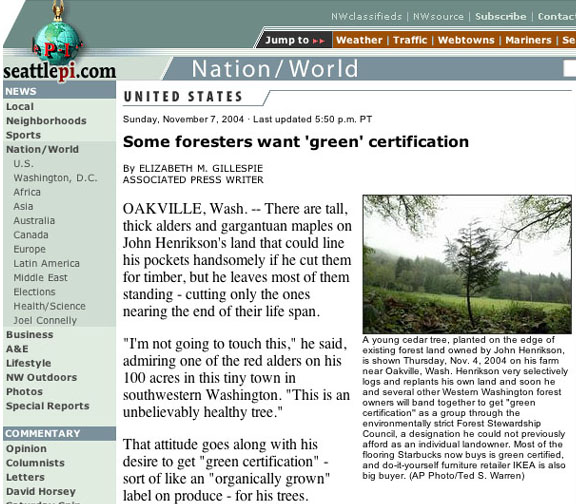











|
|
|

He's thought about trying to do that through the environmentally strict Forest Stewardship Council, an independent group based in Germany that promotes environmentally appropriate and socially beneficial use of forests, but he can't afford to do it alone. It can cost thousands of dollars just to get a tract of land checked out for that organization.
Soon, though, Henrikson and several other western Washington forest owners will band together to get certification from the council as a group. At most a five-year contract will cost him $1,000, and he'll get help marketing his eco-friendly wood to mills.
"This is a good opportunity for me," Henrikson said. "The alternative prior to this was doing it on my own, which would be too expensive and a difficult process trying to figure out by myself."
Green certification of forest products is an emerging market that's gaining ground in places like Washington state that encourage environmentally sound building techniques for big public projects.
In addition, major retailers including Home Depot and Lowe's have buying policies that favor certified wood. Most of the flooring Starbucks buys is green certified, and Swedish furniture retailer IKEA is a big buyer, said Michael Washburn, vice president of forestry and marketing for the U.S. chapter of the Forest Stewardship Council.
Landowners aren't expecting to make a quick buck because most mills aren't yet clamoring for green-certified wood. They see green certification as more of a rewarding seal of approval for the extra care they take logging their land than any sure economic bet.
"Making forestry profitable is a lot tougher than it used to be, but this program gives landowners a new opportunity to connect with consumers that value their work," said Ian Hanna, who will run the group certification program Henrikson plans to join when it launches early next year.
Homeowners planning do-it-yourself projects are not likely to find a neat stack of certified 2-by-4s at the local lumber yard. In most cases, it has to be specially ordered. It's often around 10 percent more expensive, industry experts say.
Kirk Hanson, who grows Douglas firs on 40 acres in Oakville, joined the board of the separate Northwest Natural Resource Group based in Port Angeles, Wash., a few years ago and will be one of seven pilot members in the group certification program with Henrikson. Collectively, they own 2,900 acres.
The goal is to have 50 or 60 members with some 80,000 certified acres by the end of 2006, Hanna said. By comparison, the Forest Stewardship Council certifies 45,000 acres in Washington, out of 116 million FSC-certified acres worldwide.
Eric Fritch, a mill owner in Snohomish, has been buying and selling certified wood for about three years and sees it as a promising product - especially in a region as eco-friendly as the Pacific Northwest.
He's already told the Northwest Natural Resource Group he's eager to buy more certified wood and will pay an extra $25 for every 1,000 board feet over what he pays for noncertified wood. As long as he breaks even, he said he's willing to give the market time to mature.
"I don't have the luxury of doing it from a standpoint of charity for very long," Fritch said. "You could lose money doing this in a hurry if you tried."
|

